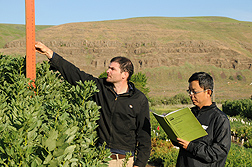Read the magazine story to find out more. |
|
New Faba Beans Offer Multiple Benefits
By Jan Suszkiw
July 27, 2016
Four cold-tolerant faba bean germplasm lines are now available for developing pulse or cover crops that can be rotated with wheat and other cereal grains grown in the Pacific Northwest.
According to the U.S. Department of Agriculture (USDA) scientists who co-developed the new germplasm lines, planting faba beans can offer both environmental and economic benefits. These include converting atmospheric nitrogen into a form subsequent crops can use for growth, forming a thick canopy that shades out weeds, protecting the soil from erosion, and nourishing it when chopped and left to decompose as a so-called “green manure.”
Although current U.S. varieties can tolerate cool temperatures and light frosts, they don’t possess true winter hardiness, according to geneticist Jinguo Hu, with USDA’s Agricultural Research Service (ARS). Shoring up that trait could allow greater flexibility in where and when growers use faba beans as an annual winter cover crop or green manure. Other benefits are fertilizer savings and extra income from harvesting the seed.
In the Palouse—a region encompassing parts of southeastern Washington State and northwestern Idaho—pea, chickpea and lentil are currently used as rotation crops with wheat, the predominant crop there. However, faba bean has the potential to extend the crop diversity in the Palouse and other U.S. regions, notes Hu, who leads ARS’s Plant Germplasm Introduction and Testing Research Unit in Pullman, Washington.
In October 2008, Hu and his ARS and Washington State University collaborators began an intensive screening effort to identify sources of winter hardiness in faba bean plant populations derived from 175 germplasm accessions collected worldwide.
From that total, the team chose several promising lines and produced six consecutive generations of offspring plants to recover and refine the hardiest individuals. They ultimately selected four lines of European descent with average winter survival rates of 84 percent during 2013-2014 field tests in southeastern Washington, where the lowest air temperatures ranged from 11 degrees Fahrenheit (F) down to minus 12.5 F during the past six winter seasons.
Read more about these faba beans in the July 2016 issue of AgResearch magazine. ARS is USDA’s principal intramural scientific research agency.

